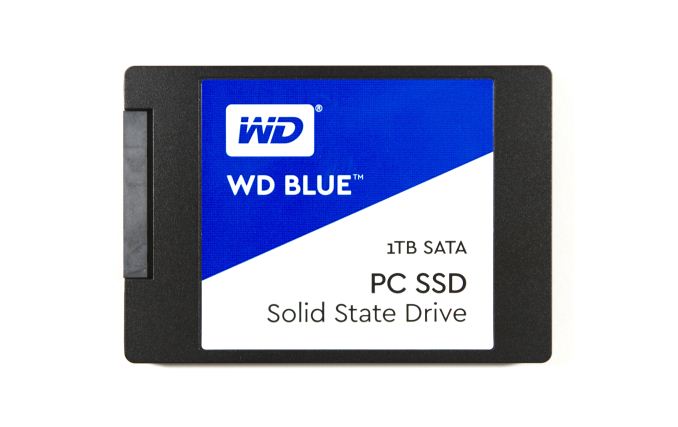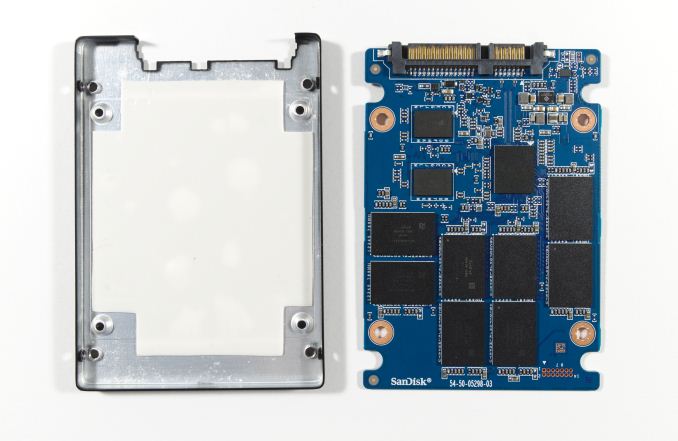The Western Digital Blue (1TB) SSD Review: WD Returns to SSDs
by Billy Tallis on October 11, 2016 8:00 AM EST- Posted in
- SSDs
- Storage
- Western Digital
- SanDisk

Five months after completing its acquisition of SanDisk, Western Digital is introducing SSDs under the WD brand for the consumer market. The WD Blue is the mainstream SATA offering and is derived from the SanDisk X400. While not exactly the first Western Digital SSD in blue, the WD Blue is the beginning of a new era for the WD brand and is an acknowledgment that SSDs are now mainstream consumer products that exist alongside or displace hard drives instead of just occupying a high-end niche.
The SanDisk X400 was announced at the beginning of this year as the new flagship of SanDisk's business/OEM client SSD family. When we reviewed it in May we were pleasantly surprised to find that it raised the bar for the performance and power efficiency of planar TLC SSDs and was a credible mid-range drive, not just an entry-level budget-oriented product. The WD Blue SSD uses the same hardware platform as the SanDisk X400, but with some changes to the firmware. Most notably, the WD Blue reserves a bit more spare area and thus has capacities of 250GB, 500GB and 1000GB where the X400 has capacities of 128GB–1024GB. There are minor differences to the performance specifications and the WD Blue has only a three year warranty compared to the X400's five years. (Though still better than the two year warranty carried by the current WD Blue hard drives.)
| Western Digital WD Blue Specifications | |||||
| Capacity | 250GB | 500GB | 1000GB | ||
| Form Factor | 2.5" 7mm SATA or M.2 2280 SATA | ||||
| Controller | Marvell 88SS1074 | ||||
| NAND | SanDisk 15nm TLC | ||||
| Sequential Read | 540 MB/s | 545 MB/s | 545 MB/s | ||
| Sequential Write | 500 MB/s | 525 MB/s | 525 MB/s | ||
| 4KB Random Read | 97k IOPS | 100k IOPS | 100k IOPS | ||
| 4KB Random Write | 79k IOPS | 80k IOPS | 80k IOPS | ||
| Average Power | 70 mW | ||||
| Max Power | 4.4 W | ||||
| Encryption | No | ||||
| Endurance (TBW) | 100 TB | 200 TB | 400 TB | ||
| Warranty | Three years | ||||
| MSRP | $79.99 | $139.99 | $299.99 | ||
All capacities of the WD Blue are available in either the 2.5" SATA form factor or as M.2 2280 cards. This continues the trend of recent mainstream SATA SSDs placing M.2 on an equal footing with the 2.5" form factor.
As a result of the increased spare area, the WD Blue has a higher write endurance rating than the SanDisk X400 and one of the highest endurance ratings of any TLC SSD. It even exceeds the rating on some capacities of the Samsung 850 Pro that comes with a 10 year warranty. Western Digital is pitching the WD Blue as suitable for heavy workloads, and even if its performance falls short of the best SATA drives it should last a very long time even when subject to a write-intensive workload.
| SSD Endurance Specifications Comparison | |||||
| Capacity | 240-256GB | 480-512GB | 960-1024GB | ||
| WD Blue | 100 TBW | 200 TBW | 400 TBW | ||
| SanDisk X400 | 80 TBW | 160 TBW | 320 TBW | ||
| OCZ Trion 150 | 60 TBW | 120 TBW | 240 TBW | ||
| OCZ VX500 | 148 TBW | 296 TBW | 592 TBW | ||
| Samsung 850 EVO | 75 TBW | 150 TBW | 150 TBW | ||
| Samsung 850 Pro | 150 TBW | 300 TBW | 300 TBW | ||
The construction of the WD Blue carries over the same metal case and plastic lid that SanDisk has been using for years. Inside our 1TB sample we find the same single-sided PCB as in the X400 and the thermal pad that covers nearly every component. The NAND is arranged in eight packages of 128GB each, while the Micron DRAM is split across two packages.
For this review the 1TB WD Blue will be compared against most of the other 1TB-class SATA drives we have tested. The current competition in the marketplace consists primarily of the preceding SanDisk X400, cheaper planar TLC SSDs such as the OCZ Trion 150, MLC SSDs that are mostly significantly more expensive, and 3D TLC SSDs such as the Samsung 850 EVO and Crucial MX300. Note that while we have already reviewed the 750GB Crucial MX300, in this review we are comparing against the 1050GB MX300 that will be covered by an upcoming review of the wider range of MX300 capacities that are now available.
| AnandTech 2015 SSD Test System | |
| CPU | Intel Core i7-4770K running at 3.5GHz (Turbo & EIST enabled, C-states disabled) |
| Motherboard | ASUS Z97 Pro (BIOS 2701) |
| Chipset | Intel Z97 |
| Memory | Corsair Vengeance DDR3-1866 2x8GB (9-10-9-27 2T) |
| Graphics | Intel HD Graphics 4600 |
| Desktop Resolution | 1920 x 1200 |
| OS | Windows 8.1 x64 |
- Thanks to Intel for the Core i7-4770K CPU
- Thanks to ASUS for the Z97 Deluxe motherboard
- Thanks to Corsair for the Vengeance 16GB DDR3-1866 DRAM kit, RM750 power supply, Carbide 200R case, and Hydro H60 CPU cooler

















75 Comments
View All Comments
TheinsanegamerN - Tuesday, October 11, 2016 - link
it's an interesting drive, but why buy these when the likes of the mushkin reactor are $60 cheaper for the 1TB varient? sata III drives have peaked performance wise.OTOH, cant wait to see what the WD black SSDs look like. 4TB? M.2 PCIE?
dave_the_nerd - Tuesday, October 11, 2016 - link
The Reactor 1TB was a clone of the BX100... which outperformed the WD Blue in a lot of tests here. Getting harder to find them though.Hopefully the street price of this will be more in-line with the rest of the market, price/performance wise.
TheinsanegamerN - Tuesday, October 11, 2016 - link
the only thing this WD drive does better is write endurance. 400TB, or even 320TB for the sandisk version, is a heck of a lot better then the 144TB of the 1TB reactor drive.ammacdo - Tuesday, October 11, 2016 - link
The thing I like most about this review is seeing how well my BX100 still holds up, and I paid the same MSRP this one is going for over a year ago.paulgj - Monday, October 31, 2016 - link
I agree, I bought half a dozen BX100's when they went on sale. Excellent MLC SSDs.Bullwinkle J Moose - Tuesday, October 11, 2016 - link
It depends on the consistency of performance and not the peakThe concern I have is Sandisk consistency of performance which cannot be checked using a single test drive
I have 3 of the Sandisk Extreme Pro thumbdrives that are Windows to Go compatible as they are "Fixed Disks"
One of them is completely unusable after a week, one is so-so and one is very good (performance wise)
The only thing that will return the speed to "Like-New" condition is using Killdisk over the entire drive
The CrapCleaner Drive wipe utility does not return full performance, and the new Defraggler SSD Optimizer does not return full performance
I have not found any method other than Killdisk to temporarily regain full disk performance
Of course, not having Trim or Garbage collection exacerbates the problem which then accelerates the thermal throttling issue
Mushkin also has a bad rep for thermal issues on their Win2Go compatible thumbdrives
The new Corsair GTX beats them all hands down for Windows to go and since my test machine is an older Sandy Bridge for XP compatability, the corsair is actually faster on the USB3 port than my Samsung 850 Pro is on the SATA2 ports
I hope Anandtech can address consistency between identical drives at some point
Bullwinkle J Moose - Tuesday, October 11, 2016 - link
Corsair GTX Thumb drives seem VERY Consistent between drives as wellWwhat - Sunday, October 30, 2016 - link
You seem to be a pretty unique case and not an average user in any way.But it's still an interesting comment I feel. Or I should say 'because of that' rather than 'still'.
Bulat Ziganshin - Saturday, October 15, 2016 - link
they can't build Black from air. sandisk best ssd is extreme pro, so Black will be updated version of itnathanddrews - Tuesday, October 11, 2016 - link
Does this WD SSD come with software to clone/shrink your existing drive to the new SSD? I have an older SiliconEdge Blue 64GB SSD (still working well) and WD offers a utility on their website to do just that, but only if there is a WD drive attached to the machine. I assume this utility would work with this SSD? Not sure if you image your test drives using different tools or what.Samsung has another great utility that comes with a slick SATA-to-USB 3.0 dongle (free in the box) that will clone/shrink any drive to a target Samsung SSD. They go above and beyond the capabilities of Windows volume shrink by a lot.